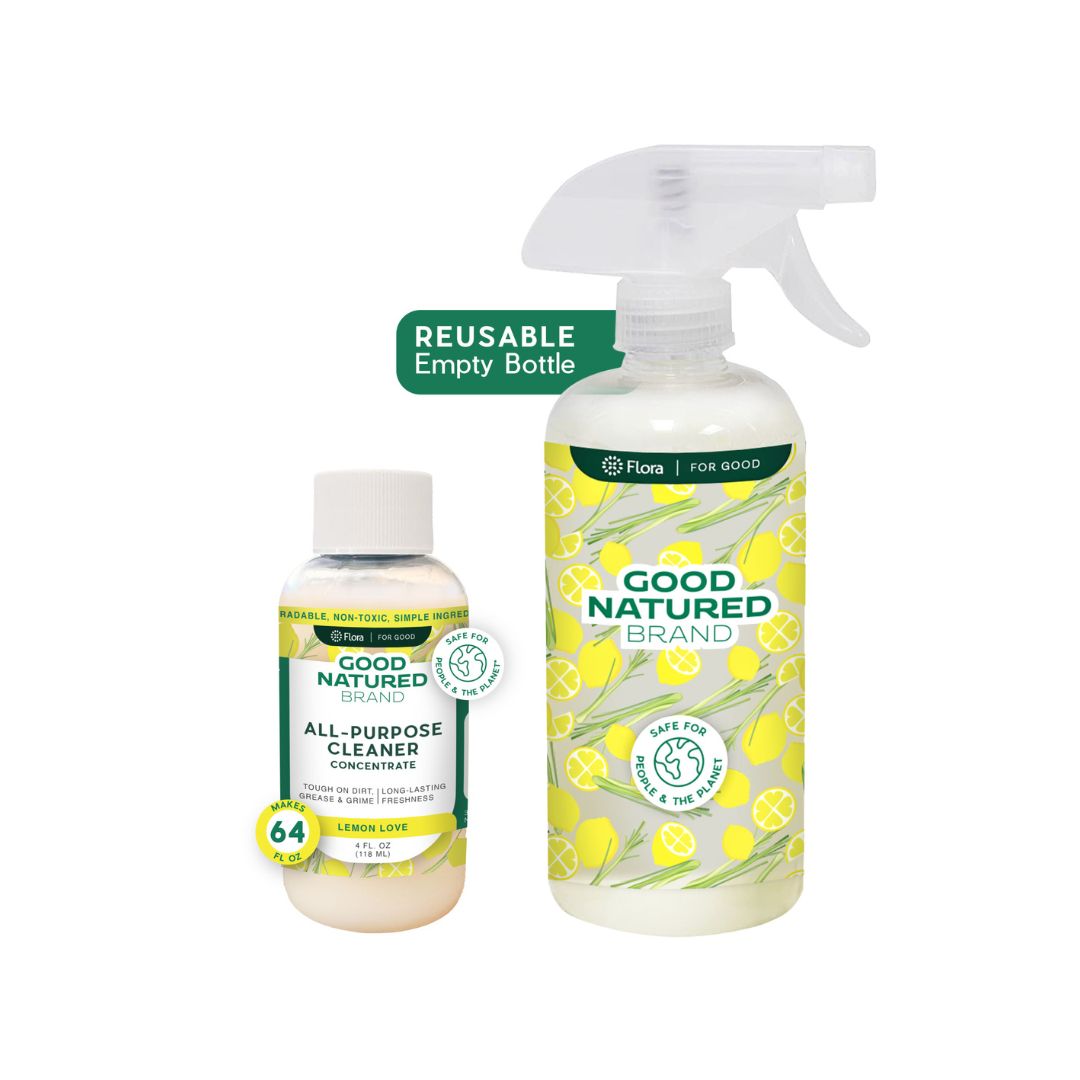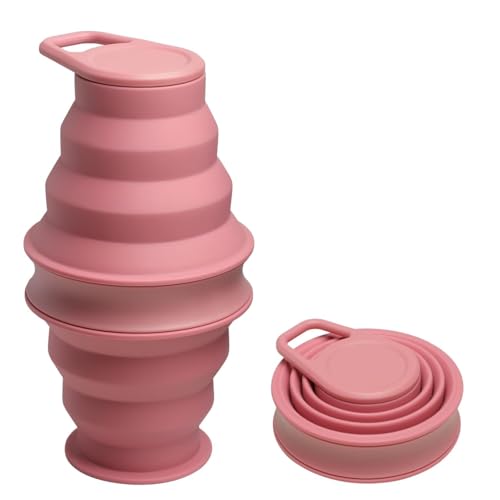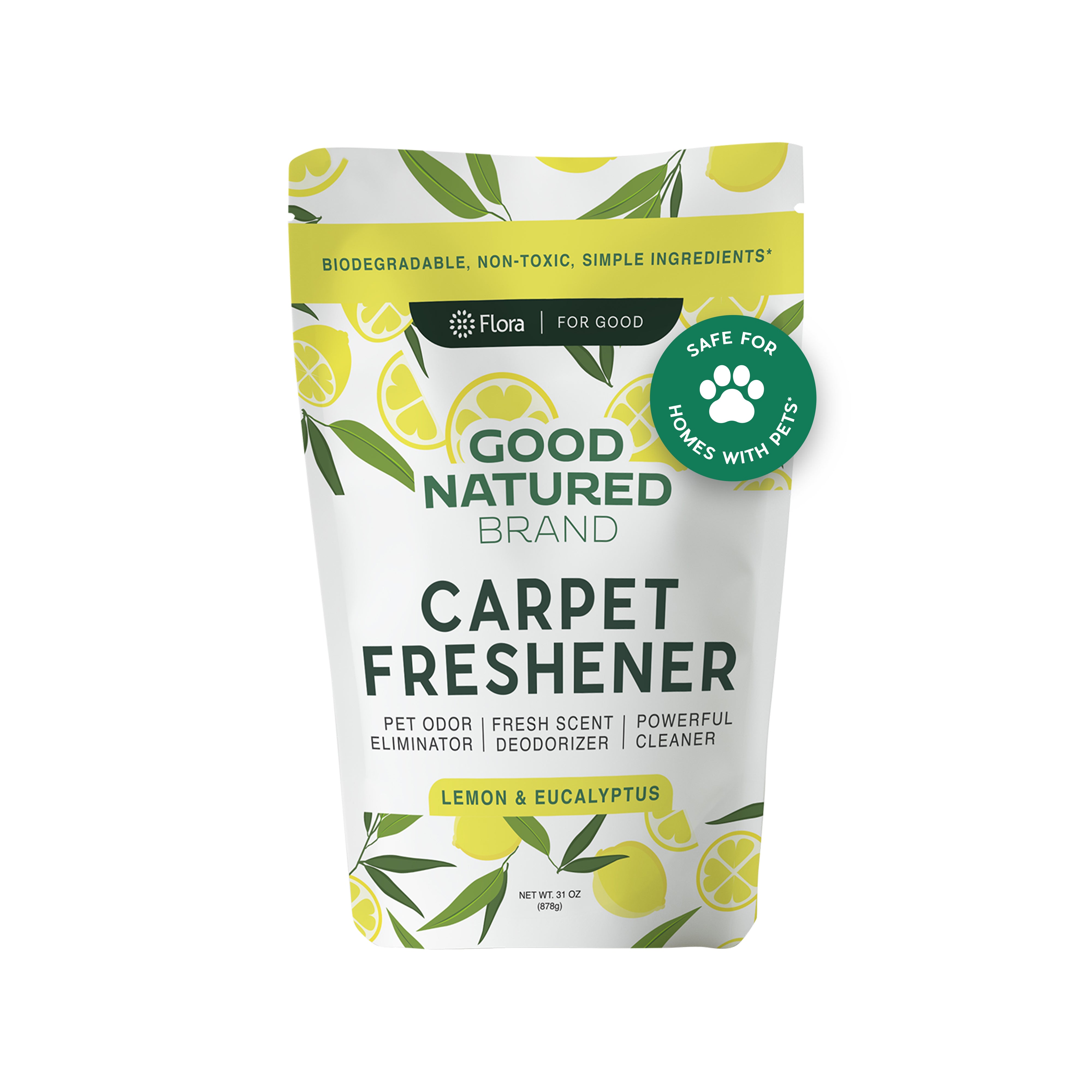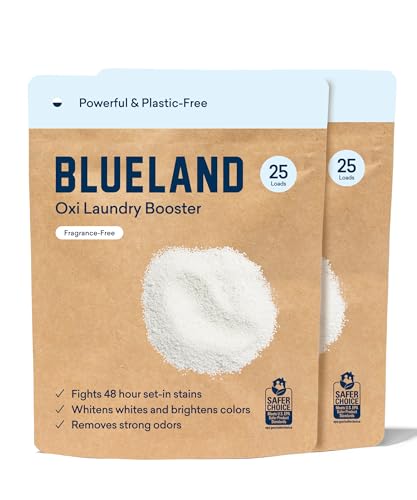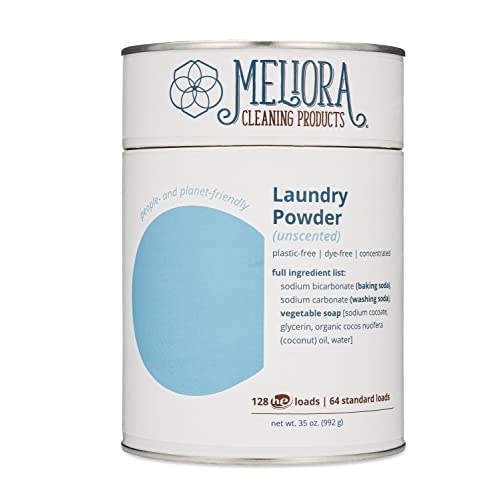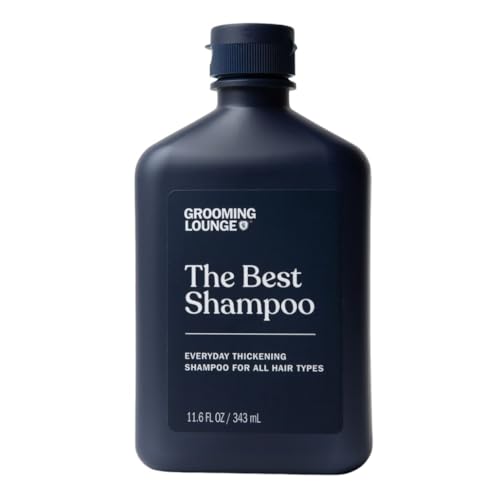
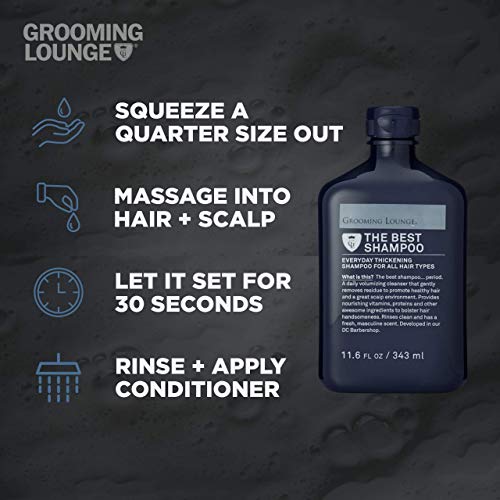
Grooming Lounge Shampoo - Scalp Clarifying, Frizz Control, Vegan - Peppermint & Rosemary - 11.6 oz


Cocamidopropyl Betaine
High RiskCocamidopropyl betaine is a synthetic surfactant derived from coconut oil, commonly used in personal care products for its mild cleansing and foaming properties. It functions as a surfactant, emulsifier, and thickening agent, contributing to the texture and performance of formulations.
Sustai Insights
Cocamidopropyl betaine offers functional benefits as a gentle surfactant, enhancing product foaming and texture. However, it may pose low to moderate allergenic risks and is subject to high use restrictions due to contamination concerns. Regulatory bodies have advised on its safe levels of usage, categorizing its risk level as high overall. Users should practice caution, particularly with sensitive populations, and consider alternatives like naturally derived surfactants for safer formulations.
Ci 42090 (Fd&C Blue No. 1 Or D&C Blue No. 4) Aluminum Lake
High RiskCI 42090, also known as FD&C Blue No. 1 or D&C Blue No. 4, is a synthetic dye commonly used in various products, primarily for its coloring properties. It is produced through industrial processes and is utilized in food, cosmetics, and pharmaceuticals to impart a blue hue.
Sustai Insights
CI 42090 serves as an effective colorant; however, it is associated with potential health risks, including enhanced skin absorption and regulatory restrictions in certain applications. While considered low to moderate risk for cancer and allergies, its environmental impact includes pollutant potential and usage limitations. Overall, the ingredient carries a high-risk score based on safety assessments and regulatory warnings. Users should adhere to recommended usage levels and consider alternatives like natural colorants for safer applications.
Methylisothiazolinone
High RiskMethylisothiazolinone is a widely-used preservative in cosmetic and personal care products, known for its antimicrobial properties. It helps prevent the growth of bacteria and fungi, extending the shelf life of formulations. It is often used in leave-on and rinse-off products, including lotions and shampoos.
Sustai Insights
Methylisothiazolinone serves as an effective preservative, combating microbial growth in various personal care items. However, it is associated with a high risk of allergic reactions and skin sensitization, especially in individuals exposed repeatedly. Regulatory bodies have imposed use restrictions due to these health concerns. Additionally, while it is not considered a carcinogen, its environmental impact includes potential pollutant characteristics. Overall, the risk associated with methylisothiazolinone is high, prompting caution and consideration of safer alternatives.
Fragrance
High RiskFragrance refers to a mixture of aromatic compounds used in products to provide scent. It is commonly listed as 'fragrance' or 'parfum' on product labels and can serve various functions, including enhancing user experience and masking undesirable odors.
Sustai Insights
Fragrance offers functional benefits by improving product appeal; however, it poses significant health risks, notably a high likelihood of causing allergies and allergic contact dermatitis. Environmental risks include potential pollution and endocrine disruption, though its overall carcinogenicity is low. Regulatory bodies have noted concerns regarding its use, leading to a high-risk classification. Safe usage practices should be observed, and alternatives such as natural essential oils are recommended for those sensitive to synthetic fragrances.
Cocamide Dipa
High RiskCocamide dipa is a fatty acid derived from coconut oil, primarily used as a surfactant and emulsifier in personal care products. It helps to stabilize formulations and improve texture, making it a common ingredient in shampoos and body washes.
Sustai Insights
Cocamide dipa offers functional benefits as a surfactant and emulsifier, enhancing product performance. However, its use is subject to restrictions due to regulatory concerns, primarily regarding potential health risks, such as irritancy and low allergenic potential. Environmental risks include pollutant characteristics, contributing to ecological harm. Overall, the ingredient is assessed as high risk due to these factors. Safe usage practices are advised, and alternatives like plant-based surfactants may be considered.
Fast Green Fcf (Uncertified Fd&C Green No. 3)
High RiskFast Green FCF, also known as FD&C Green No. 3, is a synthetic dye primarily used to impart color in food, cosmetics, and pharmaceuticals. It is classified chemically as a triphenylmethane dye and is noted for its vibrant green hue. This ingredient is subject to various regulations regarding its use and safety.
Sustai Insights
Fast Green FCF serves as an effective colorant in various applications. However, it is associated with potential health risks, including low to moderate concerns for carcinogenicity and skin absorption, and has high restrictions on its use. Environmental risks include its potential as a pollutant, with a high risk classification due to regulatory warnings. Safe usage practices should be adhered to, and alternatives such as natural colorants may offer safer options. Overall, this ingredient carries a high risk assessment.
Citric Acid
Medium RiskCitric acid is an alpha hydroxy acid used in personal care products primarily for its role as a pH adjuster and natural preservative. It occurs naturally in citrus fruits and is commonly utilized in various formulations for its chelating properties and mild exfoliation benefits.
Sustai Insights
Citric acid offers functional benefits as an effective preservative and pH stabilizer, contributing to product longevity and stability. It is biodegradable and derived from renewable sources. Health risks are low, with minimal concerns regarding carcinogenicity, allergies, and reproductive toxicity. However, moderate use restrictions exist due to potential irritation at high concentrations. Environmental risks are limited, as citric acid is not known to accumulate in ecosystems. Regulatory agencies have no significant advisories against its use. Overall, it is assessed as a medium-risk ingredient, with safe usage practices recommended and alternatives available.
Fd&C Yellow No. 5 (Ci 19140) Lake
Medium RiskFD&C Yellow No. 5 (CI 19140) Lake is a synthetic colorant used primarily in industrial production. It is derived from tartrazine and is utilized to impart a yellow hue to various products, particularly in food and cosmetics. Its formulation as a 'lake' allows for better stability and adherence in applications.
Sustai Insights
FD&C Yellow No. 5 Lake provides effective coloring in products, enhancing visual appeal. It is generally regarded as low risk for cancer and developmental toxicity, but there are moderate concerns regarding allergies and skin absorption. Regulatory bodies have imposed some use restrictions, especially for sensitive populations. Environmental risks are minimal, though it may contribute to pollution. Overall, this ingredient presents a medium risk profile, warranting careful consideration in usage and formulation.
Polyquaternium 44
Low RiskPolyquaternium-44 is a polymeric quaternary ammonium compound widely used in personal care products for its conditioning, anti-static, and film-forming properties. It enhances the texture and feel of formulations, making it particularly valuable in hair and skin care products.
Sustai Insights
Polyquaternium-44 offers functional benefits such as improved hair conditioning and anti-static properties, contributing to product efficacy. It is considered to have low health risks, with no significant concerns regarding carcinogenicity, allergies, or reproductive toxicity. Environmentally, it poses minimal pollution risk and is not flagged by regulatory agencies. Overall, it is assessed as low risk, making it a stable choice in formulations. Safe usage practices should be followed, and while there are alternatives, Polyquaternium-44 remains a suitable option in many applications.
Helianthus Annuus (Sunflower) Seed Extract
Low RiskHelianthus annuus (sunflower) seed extract is derived from sunflower seeds and is commonly used in cosmetic formulations for its emollient properties. It serves as a moisturizer and skin-conditioning agent, contributing to the overall texture and feel of products.
Sustai Insights
Helianthus annuus (sunflower) seed extract provides functional benefits such as moisturizing and skin-conditioning, while being sustainably sourced and biodegradable. Health risks are minimal, with low concerns for carcinogenicity, allergies, or reproductive toxicity. Environmental impact is also low, with no evidence of bioaccumulation or significant pollution. Regulatory status indicates no current restrictions. Overall, the ingredient is assessed to have a low risk level, making it a safe choice for cosmetic use.
Peg 120 Methyl Glucose Dioleate
Low RiskPEG-120 methyl glucose dioleate is a polyethylene glycol derivative of methyl glucose and oleic acid, primarily used as an emulsifier and surfactant in cosmetic and personal care products. It helps to stabilize formulations by allowing water and oils to mix effectively.
Sustai Insights
PEG-120 methyl glucose dioleate serves effectively as an emulsifier, enhancing product stability and texture. It is low-risk concerning carcinogenicity, allergies, and reproductive toxicity, according to regulatory assessments. However, concerns about contamination exist, necessitating cautious sourcing. Environmentally, it poses low risks, lacking bioaccumulation potential. Regulatory bodies have not issued significant warnings, supporting its low-risk classification overall. Safe usage practices should be followed, and alternatives may include plant-based emulsifiers for those seeking more sustainable options.
Vegetarian Glycerin
Low RiskVegetarian glycerin, also known as glycerol, is a colorless, odorless, and viscous liquid derived from plant sources. It is primarily used as a humectant, solvent, and emollient in various personal care products, helping to retain moisture and improve texture.
Sustai Insights
Vegetarian glycerin offers functional benefits as an effective humectant, promoting hydration and skin smoothness. It is biodegradable and typically sustainably sourced. Health risks associated with glycerin are low, with no significant concerns for carcinogenicity, allergens, or reproductive toxicity. Environmental risks are minimal, and it is not subject to major regulatory warnings. Overall, the risk level for this ingredient is low, making it a safe choice in formulations. Safe usage practices include ensuring proper concentrations in products, and alternatives such as propylene glycol exist but may have differing properties.
Peg 55
Low RiskPEG-55 is a polymer of ethylene oxide commonly used as a surfactant and emulsifier in cosmetic and personal care products. It helps to improve the texture and stability of formulations by aiding in the mixing of oil and water-based ingredients.
Sustai Insights
PEG-55 offers functional benefits as an effective emulsifier, enhancing product performance. It has a low risk of health concerns, including carcinogenicity, allergies, and reproductive toxicity, and is not associated with significant environmental hazards. Regulatory bodies have not imposed serious restrictions on its use. Overall, it presents a low risk, making it a viable ingredient in formulations. Safe usage practices should be followed, and alternatives like plant-based emulsifiers may be considered for increased sustainability.
Sodium Cocoyl Isethionate
Low RiskSodium cocoyl isethionate is a surfactant derived from coconut oil, commonly used in cosmetic formulations. It functions as a cleansing and foaming agent, contributing to the texture and effectiveness of personal care products such as shampoos and body washes. It helps to remove dirt and oils from the skin and hair.
Sustai Insights
Sodium cocoyl isethionate offers functional benefits as a gentle surfactant that effectively cleanses without stripping moisture. It is biodegradable and derived from renewable sources, enhancing its sustainability profile. Health risks are low, with minimal potential for irritation or allergies noted. Regulatory bodies have not imposed significant restrictions, indicating a favorable risk assessment overall. Usage should be within recommended concentrations to maintain safety. Alternatives include milder surfactants like decyl glucoside for those seeking gentler options. Overall, the ingredient is assessed to have a low risk.
Glycogen
Low RiskGlycogen is a high molecular weight polymer composed of glucose units, primarily functioning as an energy storage molecule in cells. It is naturally occurring in the body, particularly in liver and muscle tissues, and is utilized in various cosmetic and personal care formulations for its moisturizing properties.
Sustai Insights
Glycogen serves as an effective humectant, aiding in moisture retention and skin hydration, contributing to product stability. It is biodegradable and derived from renewable sources, aligning with sustainability goals. Health risks are minimal, with low concerns for carcinogenicity, allergies, or reproductive toxicity. Environmental hazards are negligible, and it is not subject to significant regulatory restrictions. Overall, glycogen presents low risk in its usage, making it a favorable ingredient in formulation.
Guar Hydroxypropyltrimonium Chloride
Low RiskGuar hydroxypropyltrimonium chloride is a quaternary ammonium compound derived from guar gum, primarily used as a conditioning agent in cosmetic products. It enhances the texture and feel of hair and skin formulations, providing moisture retention and improved manageability.
Sustai Insights
This ingredient offers functional benefits as a conditioning agent, improving the texture and moisture retention in formulations. It is considered low risk regarding health effects, with minimal concerns for carcinogenicity, allergies, or reproductive toxicity. Environmental risks are also low, as it does not accumulate significantly in ecosystems. Regulatory bodies have not imposed significant restrictions. Safe usage practices should be followed, but overall, this ingredient is assessed as low risk, with no immediate concerns regarding alternatives.
Sea Salt
Low RiskSea salt is a mixture of inorganic salts derived primarily from the evaporation of seawater. It consists mainly of sodium chloride, with minor amounts of other minerals. Sea salt is commonly used as a seasoning and preservative in food products and may also have applications in cosmetics and personal care items.
Sustai Insights
Sea salt serves as an effective flavor enhancer and preservative, contributing to the taste and shelf-life of food products. It is generally considered safe with low risk for health concerns such as cancer, allergies, and reproductive toxicity. Environmental impact is minimal, as it does not contribute significantly to pollution or bioaccumulation. Regulatory bodies, including the FDA, currently do not impose restrictions on its use. Overall, the risk level associated with sea salt is low, making it a widely accepted ingredient with no significant adverse effects reported.
Biotinoyl Tripeptide 1
Low RiskBiotinoyl tripeptide-1 is the reaction product of biotin and a tripeptide, primarily used in cosmetic formulations for its potential benefits in hair and skin care. It is known for its role in promoting hair growth and improving the overall appearance of hair and skin by enhancing moisture retention and elasticity.
Sustai Insights
Biotinoyl tripeptide-1 offers functional benefits as a hair and skin conditioning agent, promoting moisture retention and potentially aiding in hair growth. It is not currently associated with significant health risks, including carcinogenicity, allergies, or reproductive toxicity, and is deemed safe for use with low regulatory concerns. Environmental risks are minimal, and it does not present bioaccumulation issues. Overall, the ingredient is considered low risk, making it a favorable choice in cosmetic applications, though alternatives such as other peptides may offer similar benefits.
Disodium Laureth Sulfosuccinate
Low RiskDisodium laureth sulfosuccinate is a disodium salt derived from sulfosuccinic acid and laureth alcohol, commonly used as a surfactant and cleansing agent in personal care products. It functions primarily to reduce surface tension and enhance foaming properties, making it effective in formulations like shampoos and body washes.
Sustai Insights
Disodium laureth sulfosuccinate is effective for its cleansing and foaming properties, while being low in common health concerns such as carcinogenicity and allergenic potential. It poses minimal environmental risks and is not known to bioaccumulate. Regulatory bodies do not impose significant restrictions, indicating a low overall risk. Safe usage practices should be observed, and alternatives like milder surfactants may be considered for sensitive formulations, but the ingredient remains a suitable choice in many applications.
Neomenthol
Low RiskNeomenthol is a menthol derivative commonly used for its cooling sensation in cosmetic and topical formulations. It acts primarily as a fragrance component and a soothing agent, contributing to the sensory attributes of products such as creams and ointments.
Sustai Insights
Neomenthol offers functional benefits, including its cooling effect and soothing properties in topical applications. It is not associated with significant health risks, as concerns regarding carcinogenicity, allergies, and toxicity are low. Environmentally, it poses minimal risks and is not classified as a pollutant. Regulatory status indicates no current restrictions. Overall, its risk level is assessed as low, making it a safe option for use in personal care products.
Peg 8 Dimethicone
Low RiskPEG-8 dimethicone is a polyethylene glycol derivative of dimethicone, primarily used as a conditioning agent and emollient in cosmetic and personal care products. It enhances product texture and spreadability while providing a smooth finish on the skin.
Sustai Insights
PEG-8 dimethicone offers functional benefits, including improved product application and skin feel. It is associated with low health risks such as carcinogenicity, allergies, and developmental toxicity. However, concerns regarding contamination exist. The ingredient is generally recognized as safe under regulatory standards, posing low overall risk. For those seeking alternatives, silicone-free options like natural oils may be considered.
Tetrasodium Edta
Low RiskTetrasodium EDTA (ethylenediaminetetraacetic acid) is a chelating agent commonly used in personal care and cosmetic products. It functions by binding to metal ions, which helps to stabilize formulations and enhance the effectiveness of preservatives. This ingredient is typically employed to prevent product degradation and improve shelf life.
Sustai Insights
Tetrasodium EDTA is effective in stabilizing products and preventing metal ion-induced degradation, contributing to enhanced shelf life. It is generally regarded as low risk for health concerns, including carcinogenicity and allergies, with minimal environmental impact as it is not bioaccumulative. Regulatory bodies have not imposed significant restrictions on its use, though some caution is advised regarding its environmental persistence. Overall, the risk associated with tetrasodium EDTA is low, and safer alternatives may include natural chelating agents like citric acid.
Sodium Lauryl Sulfoacetate
Low RiskSodium lauryl sulfoacetate is an organic salt commonly used as a surfactant in cosmetic formulations. It acts as a cleansing and foaming agent, helping to emulsify and remove dirt and oils from skin and hair products.
Sustai Insights
Sodium lauryl sulfoacetate is effective as a gentle surfactant, providing cleansing properties without harshness. It is generally recognized as safe with low concerns regarding carcinogenicity, allergenic potential, and reproductive toxicity. Environmentally, it poses low risk for pollution and bioaccumulation. Regulatory bodies have not imposed significant restrictions, indicating its acceptance in cosmetic formulations. Overall, it is assessed as low risk for consumer use, making it a favorable option in personal care products. Alternatives include milder surfactants like decyl glucoside for those seeking even gentler options.
Water
Low RiskWater is a clear, colorless liquid essential for various biological processes. It serves as a solvent in formulations, facilitating the dissolution of other ingredients and enhancing product texture and application. Additionally, water plays a crucial role in hydration and is a key component in many cosmetic and personal care products.
Sustai Insights
Water is an effective solvent and hydrator, contributing to the texture and efficacy of formulations. It is biodegradable and generally regarded as safe, with low concerns regarding carcinogenicity, allergies, and reproductive toxicity. However, excessive water usage can lead to environmental concerns, particularly regarding resource depletion. Regulatory bodies do not impose restrictions on water use in cosmetics. Overall, the risks associated with water are low, making it a safe and essential ingredient.
Polyquaternium 44
Low RiskPolyquaternium-44 is a polymeric quaternary ammonium compound widely used in personal care products for its conditioning, anti-static, and film-forming properties. It enhances the texture and feel of formulations, making it particularly valuable in hair and skin care products.
Sustai Insights
Polyquaternium-44 offers functional benefits such as improved hair conditioning and anti-static properties, contributing to product efficacy. It is considered to have low health risks, with no significant concerns regarding carcinogenicity, allergies, or reproductive toxicity. Environmentally, it poses minimal pollution risk and is not flagged by regulatory agencies. Overall, it is assessed as low risk, making it a stable choice in formulations. Safe usage practices should be followed, and while there are alternatives, Polyquaternium-44 remains a suitable option in many applications.
Helianthus Annuus (Sunflower) Seed Extract
Low RiskHelianthus annuus (sunflower) seed extract is derived from sunflower seeds and is commonly used in cosmetic formulations for its emollient properties. It serves as a moisturizer and skin-conditioning agent, contributing to the overall texture and feel of products.
Sustai Insights
Helianthus annuus (sunflower) seed extract provides functional benefits such as moisturizing and skin-conditioning, while being sustainably sourced and biodegradable. Health risks are minimal, with low concerns for carcinogenicity, allergies, or reproductive toxicity. Environmental impact is also low, with no evidence of bioaccumulation or significant pollution. Regulatory status indicates no current restrictions. Overall, the ingredient is assessed to have a low risk level, making it a safe choice for cosmetic use.
Peg 120 Methyl Glucose Dioleate
Low RiskPEG-120 methyl glucose dioleate is a polyethylene glycol derivative of methyl glucose and oleic acid, primarily used as an emulsifier and surfactant in cosmetic and personal care products. It helps to stabilize formulations by allowing water and oils to mix effectively.
Sustai Insights
PEG-120 methyl glucose dioleate serves effectively as an emulsifier, enhancing product stability and texture. It is low-risk concerning carcinogenicity, allergies, and reproductive toxicity, according to regulatory assessments. However, concerns about contamination exist, necessitating cautious sourcing. Environmentally, it poses low risks, lacking bioaccumulation potential. Regulatory bodies have not issued significant warnings, supporting its low-risk classification overall. Safe usage practices should be followed, and alternatives may include plant-based emulsifiers for those seeking more sustainable options.
Vegetarian Glycerin
Low RiskVegetarian glycerin, also known as glycerol, is a colorless, odorless, and viscous liquid derived from plant sources. It is primarily used as a humectant, solvent, and emollient in various personal care products, helping to retain moisture and improve texture.
Sustai Insights
Vegetarian glycerin offers functional benefits as an effective humectant, promoting hydration and skin smoothness. It is biodegradable and typically sustainably sourced. Health risks associated with glycerin are low, with no significant concerns for carcinogenicity, allergens, or reproductive toxicity. Environmental risks are minimal, and it is not subject to major regulatory warnings. Overall, the risk level for this ingredient is low, making it a safe choice in formulations. Safe usage practices include ensuring proper concentrations in products, and alternatives such as propylene glycol exist but may have differing properties.
Peg 55
Low RiskPEG-55 is a polymer of ethylene oxide commonly used as a surfactant and emulsifier in cosmetic and personal care products. It helps to improve the texture and stability of formulations by aiding in the mixing of oil and water-based ingredients.
Sustai Insights
PEG-55 offers functional benefits as an effective emulsifier, enhancing product performance. It has a low risk of health concerns, including carcinogenicity, allergies, and reproductive toxicity, and is not associated with significant environmental hazards. Regulatory bodies have not imposed serious restrictions on its use. Overall, it presents a low risk, making it a viable ingredient in formulations. Safe usage practices should be followed, and alternatives like plant-based emulsifiers may be considered for increased sustainability.
Sodium Cocoyl Isethionate
Low RiskSodium cocoyl isethionate is a surfactant derived from coconut oil, commonly used in cosmetic formulations. It functions as a cleansing and foaming agent, contributing to the texture and effectiveness of personal care products such as shampoos and body washes. It helps to remove dirt and oils from the skin and hair.
Sustai Insights
Sodium cocoyl isethionate offers functional benefits as a gentle surfactant that effectively cleanses without stripping moisture. It is biodegradable and derived from renewable sources, enhancing its sustainability profile. Health risks are low, with minimal potential for irritation or allergies noted. Regulatory bodies have not imposed significant restrictions, indicating a favorable risk assessment overall. Usage should be within recommended concentrations to maintain safety. Alternatives include milder surfactants like decyl glucoside for those seeking gentler options. Overall, the ingredient is assessed to have a low risk.
Citric Acid
Medium RiskCitric acid is an alpha hydroxy acid used in personal care products primarily for its role as a pH adjuster and natural preservative. It occurs naturally in citrus fruits and is commonly utilized in various formulations for its chelating properties and mild exfoliation benefits.
Sustai Insights
Citric acid offers functional benefits as an effective preservative and pH stabilizer, contributing to product longevity and stability. It is biodegradable and derived from renewable sources. Health risks are low, with minimal concerns regarding carcinogenicity, allergies, and reproductive toxicity. However, moderate use restrictions exist due to potential irritation at high concentrations. Environmental risks are limited, as citric acid is not known to accumulate in ecosystems. Regulatory agencies have no significant advisories against its use. Overall, it is assessed as a medium-risk ingredient, with safe usage practices recommended and alternatives available.
Cocamidopropyl Betaine
High RiskCocamidopropyl betaine is a synthetic surfactant derived from coconut oil, commonly used in personal care products for its mild cleansing and foaming properties. It functions as a surfactant, emulsifier, and thickening agent, contributing to the texture and performance of formulations.
Sustai Insights
Cocamidopropyl betaine offers functional benefits as a gentle surfactant, enhancing product foaming and texture. However, it may pose low to moderate allergenic risks and is subject to high use restrictions due to contamination concerns. Regulatory bodies have advised on its safe levels of usage, categorizing its risk level as high overall. Users should practice caution, particularly with sensitive populations, and consider alternatives like naturally derived surfactants for safer formulations.
Ci 42090 (Fd&C Blue No. 1 Or D&C Blue No. 4) Aluminum Lake
High RiskCI 42090, also known as FD&C Blue No. 1 or D&C Blue No. 4, is a synthetic dye commonly used in various products, primarily for its coloring properties. It is produced through industrial processes and is utilized in food, cosmetics, and pharmaceuticals to impart a blue hue.
Sustai Insights
CI 42090 serves as an effective colorant; however, it is associated with potential health risks, including enhanced skin absorption and regulatory restrictions in certain applications. While considered low to moderate risk for cancer and allergies, its environmental impact includes pollutant potential and usage limitations. Overall, the ingredient carries a high-risk score based on safety assessments and regulatory warnings. Users should adhere to recommended usage levels and consider alternatives like natural colorants for safer applications.
Glycogen
Low RiskGlycogen is a high molecular weight polymer composed of glucose units, primarily functioning as an energy storage molecule in cells. It is naturally occurring in the body, particularly in liver and muscle tissues, and is utilized in various cosmetic and personal care formulations for its moisturizing properties.
Sustai Insights
Glycogen serves as an effective humectant, aiding in moisture retention and skin hydration, contributing to product stability. It is biodegradable and derived from renewable sources, aligning with sustainability goals. Health risks are minimal, with low concerns for carcinogenicity, allergies, or reproductive toxicity. Environmental hazards are negligible, and it is not subject to significant regulatory restrictions. Overall, glycogen presents low risk in its usage, making it a favorable ingredient in formulation.
Methylisothiazolinone
High RiskMethylisothiazolinone is a widely-used preservative in cosmetic and personal care products, known for its antimicrobial properties. It helps prevent the growth of bacteria and fungi, extending the shelf life of formulations. It is often used in leave-on and rinse-off products, including lotions and shampoos.
Sustai Insights
Methylisothiazolinone serves as an effective preservative, combating microbial growth in various personal care items. However, it is associated with a high risk of allergic reactions and skin sensitization, especially in individuals exposed repeatedly. Regulatory bodies have imposed use restrictions due to these health concerns. Additionally, while it is not considered a carcinogen, its environmental impact includes potential pollutant characteristics. Overall, the risk associated with methylisothiazolinone is high, prompting caution and consideration of safer alternatives.
Guar Hydroxypropyltrimonium Chloride
Low RiskGuar hydroxypropyltrimonium chloride is a quaternary ammonium compound derived from guar gum, primarily used as a conditioning agent in cosmetic products. It enhances the texture and feel of hair and skin formulations, providing moisture retention and improved manageability.
Sustai Insights
This ingredient offers functional benefits as a conditioning agent, improving the texture and moisture retention in formulations. It is considered low risk regarding health effects, with minimal concerns for carcinogenicity, allergies, or reproductive toxicity. Environmental risks are also low, as it does not accumulate significantly in ecosystems. Regulatory bodies have not imposed significant restrictions. Safe usage practices should be followed, but overall, this ingredient is assessed as low risk, with no immediate concerns regarding alternatives.
Sea Salt
Low RiskSea salt is a mixture of inorganic salts derived primarily from the evaporation of seawater. It consists mainly of sodium chloride, with minor amounts of other minerals. Sea salt is commonly used as a seasoning and preservative in food products and may also have applications in cosmetics and personal care items.
Sustai Insights
Sea salt serves as an effective flavor enhancer and preservative, contributing to the taste and shelf-life of food products. It is generally considered safe with low risk for health concerns such as cancer, allergies, and reproductive toxicity. Environmental impact is minimal, as it does not contribute significantly to pollution or bioaccumulation. Regulatory bodies, including the FDA, currently do not impose restrictions on its use. Overall, the risk level associated with sea salt is low, making it a widely accepted ingredient with no significant adverse effects reported.
Biotinoyl Tripeptide 1
Low RiskBiotinoyl tripeptide-1 is the reaction product of biotin and a tripeptide, primarily used in cosmetic formulations for its potential benefits in hair and skin care. It is known for its role in promoting hair growth and improving the overall appearance of hair and skin by enhancing moisture retention and elasticity.
Sustai Insights
Biotinoyl tripeptide-1 offers functional benefits as a hair and skin conditioning agent, promoting moisture retention and potentially aiding in hair growth. It is not currently associated with significant health risks, including carcinogenicity, allergies, or reproductive toxicity, and is deemed safe for use with low regulatory concerns. Environmental risks are minimal, and it does not present bioaccumulation issues. Overall, the ingredient is considered low risk, making it a favorable choice in cosmetic applications, though alternatives such as other peptides may offer similar benefits.
Disodium Laureth Sulfosuccinate
Low RiskDisodium laureth sulfosuccinate is a disodium salt derived from sulfosuccinic acid and laureth alcohol, commonly used as a surfactant and cleansing agent in personal care products. It functions primarily to reduce surface tension and enhance foaming properties, making it effective in formulations like shampoos and body washes.
Sustai Insights
Disodium laureth sulfosuccinate is effective for its cleansing and foaming properties, while being low in common health concerns such as carcinogenicity and allergenic potential. It poses minimal environmental risks and is not known to bioaccumulate. Regulatory bodies do not impose significant restrictions, indicating a low overall risk. Safe usage practices should be observed, and alternatives like milder surfactants may be considered for sensitive formulations, but the ingredient remains a suitable choice in many applications.
Neomenthol
Low RiskNeomenthol is a menthol derivative commonly used for its cooling sensation in cosmetic and topical formulations. It acts primarily as a fragrance component and a soothing agent, contributing to the sensory attributes of products such as creams and ointments.
Sustai Insights
Neomenthol offers functional benefits, including its cooling effect and soothing properties in topical applications. It is not associated with significant health risks, as concerns regarding carcinogenicity, allergies, and toxicity are low. Environmentally, it poses minimal risks and is not classified as a pollutant. Regulatory status indicates no current restrictions. Overall, its risk level is assessed as low, making it a safe option for use in personal care products.
Fragrance
High RiskFragrance refers to a mixture of aromatic compounds used in products to provide scent. It is commonly listed as 'fragrance' or 'parfum' on product labels and can serve various functions, including enhancing user experience and masking undesirable odors.
Sustai Insights
Fragrance offers functional benefits by improving product appeal; however, it poses significant health risks, notably a high likelihood of causing allergies and allergic contact dermatitis. Environmental risks include potential pollution and endocrine disruption, though its overall carcinogenicity is low. Regulatory bodies have noted concerns regarding its use, leading to a high-risk classification. Safe usage practices should be observed, and alternatives such as natural essential oils are recommended for those sensitive to synthetic fragrances.
Peg 8 Dimethicone
Low RiskPEG-8 dimethicone is a polyethylene glycol derivative of dimethicone, primarily used as a conditioning agent and emollient in cosmetic and personal care products. It enhances product texture and spreadability while providing a smooth finish on the skin.
Sustai Insights
PEG-8 dimethicone offers functional benefits, including improved product application and skin feel. It is associated with low health risks such as carcinogenicity, allergies, and developmental toxicity. However, concerns regarding contamination exist. The ingredient is generally recognized as safe under regulatory standards, posing low overall risk. For those seeking alternatives, silicone-free options like natural oils may be considered.
Tetrasodium Edta
Low RiskTetrasodium EDTA (ethylenediaminetetraacetic acid) is a chelating agent commonly used in personal care and cosmetic products. It functions by binding to metal ions, which helps to stabilize formulations and enhance the effectiveness of preservatives. This ingredient is typically employed to prevent product degradation and improve shelf life.
Sustai Insights
Tetrasodium EDTA is effective in stabilizing products and preventing metal ion-induced degradation, contributing to enhanced shelf life. It is generally regarded as low risk for health concerns, including carcinogenicity and allergies, with minimal environmental impact as it is not bioaccumulative. Regulatory bodies have not imposed significant restrictions on its use, though some caution is advised regarding its environmental persistence. Overall, the risk associated with tetrasodium EDTA is low, and safer alternatives may include natural chelating agents like citric acid.
Cocamide Dipa
High RiskCocamide dipa is a fatty acid derived from coconut oil, primarily used as a surfactant and emulsifier in personal care products. It helps to stabilize formulations and improve texture, making it a common ingredient in shampoos and body washes.
Sustai Insights
Cocamide dipa offers functional benefits as a surfactant and emulsifier, enhancing product performance. However, its use is subject to restrictions due to regulatory concerns, primarily regarding potential health risks, such as irritancy and low allergenic potential. Environmental risks include pollutant characteristics, contributing to ecological harm. Overall, the ingredient is assessed as high risk due to these factors. Safe usage practices are advised, and alternatives like plant-based surfactants may be considered.
Fd&C Yellow No. 5 (Ci 19140) Lake
Medium RiskFD&C Yellow No. 5 (CI 19140) Lake is a synthetic colorant used primarily in industrial production. It is derived from tartrazine and is utilized to impart a yellow hue to various products, particularly in food and cosmetics. Its formulation as a 'lake' allows for better stability and adherence in applications.
Sustai Insights
FD&C Yellow No. 5 Lake provides effective coloring in products, enhancing visual appeal. It is generally regarded as low risk for cancer and developmental toxicity, but there are moderate concerns regarding allergies and skin absorption. Regulatory bodies have imposed some use restrictions, especially for sensitive populations. Environmental risks are minimal, though it may contribute to pollution. Overall, this ingredient presents a medium risk profile, warranting careful consideration in usage and formulation.
Sodium Lauryl Sulfoacetate
Low RiskSodium lauryl sulfoacetate is an organic salt commonly used as a surfactant in cosmetic formulations. It acts as a cleansing and foaming agent, helping to emulsify and remove dirt and oils from skin and hair products.
Sustai Insights
Sodium lauryl sulfoacetate is effective as a gentle surfactant, providing cleansing properties without harshness. It is generally recognized as safe with low concerns regarding carcinogenicity, allergenic potential, and reproductive toxicity. Environmentally, it poses low risk for pollution and bioaccumulation. Regulatory bodies have not imposed significant restrictions, indicating its acceptance in cosmetic formulations. Overall, it is assessed as low risk for consumer use, making it a favorable option in personal care products. Alternatives include milder surfactants like decyl glucoside for those seeking even gentler options.
Water
Low RiskWater is a clear, colorless liquid essential for various biological processes. It serves as a solvent in formulations, facilitating the dissolution of other ingredients and enhancing product texture and application. Additionally, water plays a crucial role in hydration and is a key component in many cosmetic and personal care products.
Sustai Insights
Water is an effective solvent and hydrator, contributing to the texture and efficacy of formulations. It is biodegradable and generally regarded as safe, with low concerns regarding carcinogenicity, allergies, and reproductive toxicity. However, excessive water usage can lead to environmental concerns, particularly regarding resource depletion. Regulatory bodies do not impose restrictions on water use in cosmetics. Overall, the risks associated with water are low, making it a safe and essential ingredient.
Fast Green Fcf (Uncertified Fd&C Green No. 3)
High RiskFast Green FCF, also known as FD&C Green No. 3, is a synthetic dye primarily used to impart color in food, cosmetics, and pharmaceuticals. It is classified chemically as a triphenylmethane dye and is noted for its vibrant green hue. This ingredient is subject to various regulations regarding its use and safety.
Sustai Insights
Fast Green FCF serves as an effective colorant in various applications. However, it is associated with potential health risks, including low to moderate concerns for carcinogenicity and skin absorption, and has high restrictions on its use. Environmental risks include its potential as a pollutant, with a high risk classification due to regulatory warnings. Safe usage practices should be adhered to, and alternatives such as natural colorants may offer safer options. Overall, this ingredient carries a high risk assessment.
Discover Grooming Lounge's The Best Shampoo, a scalp-clarifying, frizz-controlling hair wash designed for men. Infused with invigorating peppermint and rosemary, this shampoo promotes hair growth while ensuring a clean, hydrated scalp. Perfect for daily use, it balances moisture and reduces buildup, leaving hair thicker and softer over time.
- Gentle Cleansing: This lightweight formula effectively removes grease and product residue without stripping moisture, making it ideal for everyday use.
- Natural Ingredients: Enriched with plant-derived extracts, it hydrates and soothes dry or itchy scalps, promoting overall hair health.
- Refreshing Fragrance: The stimulating scent of peppermint revitalizes the senses, making each wash a refreshing experience.
- Health-Conscious Formula: Vegan-friendly and free from parabens and sulfates, this shampoo supports your commitment to eco-friendly grooming.
- Barber-Crafted Quality: Developed by professional barbers, this shampoo is trusted for its effectiveness in promoting hair length and strength.
Subscribe & Save with Sustai
- Best Price Guarantee: Always enjoy the lowest prices on sustainable home essentials.
- No Surprises: We’ll notify you before shipping. No hidden fees, ever.
- You’re in Charge: Change, pause, or cancel your subscription anytime with ease.
- Eco-Friendly Deliveries: Our grouped shipments mean less packaging and lower emissions.
Join us on a sustainable journey. Special offers for a limited time! Prices and promotions may change.
Recommended Products
Discover Grooming Lounge's The Best Shampoo, a scalp-clarifying, frizz-controlling hair wash designed for men. Infused with invigorating peppermint and rosemary, this shampoo promotes hair growth while ensuring a clean, hydrated scalp. Perfect for daily use, it balances moisture and reduces buildup, leaving hair thicker and softer over time.
- Gentle Cleansing: This lightweight formula effectively removes grease and product residue without stripping moisture, making it ideal for everyday use.
- Natural Ingredients: Enriched with plant-derived extracts, it hydrates and soothes dry or itchy scalps, promoting overall hair health.
- Refreshing Fragrance: The stimulating scent of peppermint revitalizes the senses, making each wash a refreshing experience.
- Health-Conscious Formula: Vegan-friendly and free from parabens and sulfates, this shampoo supports your commitment to eco-friendly grooming.
- Barber-Crafted Quality: Developed by professional barbers, this shampoo is trusted for its effectiveness in promoting hair length and strength.

You can have at most 2 Sustainable Steals products in your cart
Customer Reviews
Customers’ View
Customers appreciate the quality and effectiveness of this shampoo, noting its gentle cleansing properties and refreshing feel. Many users highlight its ability to leave hair clean, manageable, and noticeably thicker without causing dryness. The scent, described as pleasant and fresh, enhances the overall experience, with some likening it to mint chocolate chip ice cream. Additionally, the product's eco-friendly formulation, being vegan-friendly and free from sulfates and parabens, resonates well with environmentally conscious consumers. Overall, users find this shampoo to align with their health and sustainability values while delivering reliable performance.
AI-generated from the text of customer reviewsThis product has no reviews yet.
